Actinidia - care in the fall and preparation for winter
Having planted an exotic perennial tree-like liana actinidia for the first time on their site, closer to the arrival of winter, novice gardeners begin to worry about its safety. Their experiences are quite justified: the plant migrated to our region from southeast Asia, where the climate differs significantly from the conditions of the same South (for example, the Volgograd region) and even more so from the Middle zone (Moscow region). Therefore, in order for the vine to bloom safely in the spring, it needs proper autumn care and preparation for winter.
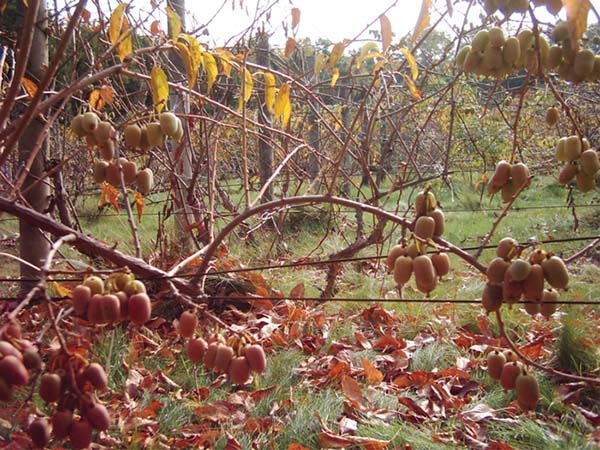
Content
How to care for actinidia in the fall to properly prepare for winter
What is the preparation of actinidia for winter, what work should be done in the fall?
Care measures are more than standard:
- top dressing;
The standard "Autumn" phosphorus-potassium fertilizer, eg, superphosphate and potassium sulfate (potassium sulfate) or some analogue.
But the best (although quite expensive) is to use potassium monophosphatesincefertilizer will act instantly, and this will have a positive effect on the maturation of young shoots, which more budgetary simply sprinkle with potassium sulfate solution (potassium sulfate).
- trimming;
- shelter for the winter.
Next, let's talk in more detail about autumn pruning, the need and ways to shelter actinidia for the winter.
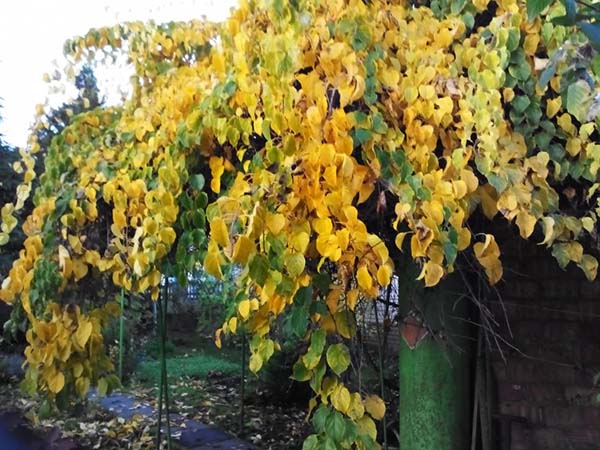
Pruning actinidia in fall, spring and summer: when and how to prune
Due to the fact that actinidia very quickly grows shoots, in order to prevent a strong thickening of the crown and attack on neighboring plants (if located close), the vine will need to be cut periodically.
In actinidia, only the "excess" is cut off. If the liana does not interfere, then there is no need to cut it!
Also, the plant trimmed regularly when shaped (usually 3-4 sleeves, like grapes).
Actinidia bears fruit, as a rule, on 3-year-old wood, on the sleeves, like grapes, which means that the shoots need to be periodically rejuvenated and cut (shaped).
By the way! The site has a very detailed article about when and how to prune grapes in autumn.
It is believed that the optimal time for pruning actinidia occurs in early spring, when the plant has not yet woken up, i.e. before the beginning of the growing season.
However, some gardeners, on the contrary, are of the opinion that the main pruning of actinidia should be carried out precisely in late autumn, after leaf fall.
Video: pruning actinidia
Autumn pruning
As soon as stable subzero temperatures are established at night, and the vine begins to shed its leaves, you can start autumn pruning.
Depending on the weather of the climatic zone where actinidia is grown, autumn pruning is carried out in October-November.
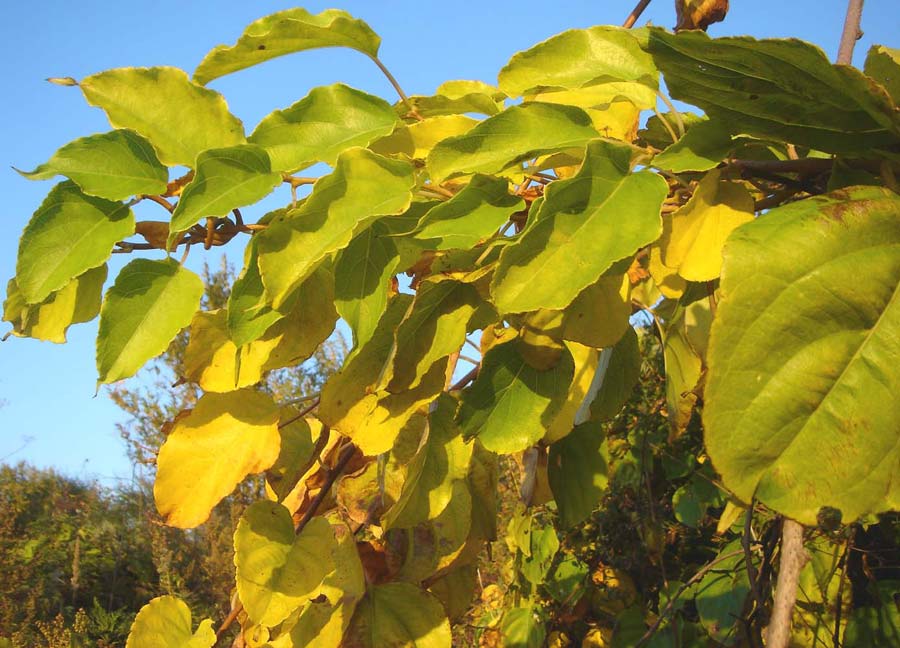
What to prune in the fall?
It is necessary prune all unripe shoots (green)shortening them to ripe (brown).
Also held sanitary pruning of dried shoots (pruned to healthy wood).
Pruning in spring
It is advisable to prune actinidia even in winter, so that the trimmed ends of the plant have time to heal before spring, otherwise it will "cry" very much.
If a full spring (thaw) in your region begins only in April, then pruning should be carried out in February-March.
If we draw parallels, then, for example, actinidium Argut, grown and pruned similarly to grapes.
So, in the spring, branches that have dried up (sanitary pruning) and branches that literally choke others should be cut (this happens very often, and you need to do something about it).
Summer pruning
If you want to get the maximum yield, then in the summer you will need to prune the creeper in order to rid it of unnecessary thickening shoots. Such a pinching including will speed up their maturation (carried out similarly minting grapes).
Shelter actinidia for the winter
Do I need to cover
Some types of actinidia easily tolerate frosts down to -35 degrees (according to some sources, even up to -50).
First of all, we are talking about such a variety as Kolomikta, but Arguta is also quite frost-resistant (but less than Kolomikta).
But in view of the fact that the root system of actinidia is superficial (located very close to the surface of the earth), it is still necessary to mulch around the root collar. Such a shelter will be quite enough for a successful overwintering of an adult plant.
Interesting! They continue to make shelter for old bushes not for the purpose of insulation for the winter, but for protection from cats! Why? Read on in a separate paragraph.
However, young bushes (planted this spring or fall) in the first couple of years after planting, they require mandatory shelter for the winter, otherwise in spring you will see green leaves only at the bottom of the bush, and long lashes may freeze completely ...
Of course, mature plants may not be removed from the support (And how else to grow them on a veranda, arch or fence?), But if the winter turns out to be harsh, with little snow or, even worse, snowless, then the outcome may be the saddest ... And although the bushes will definitely recover and, perhaps, even bear fruit, but minimal.
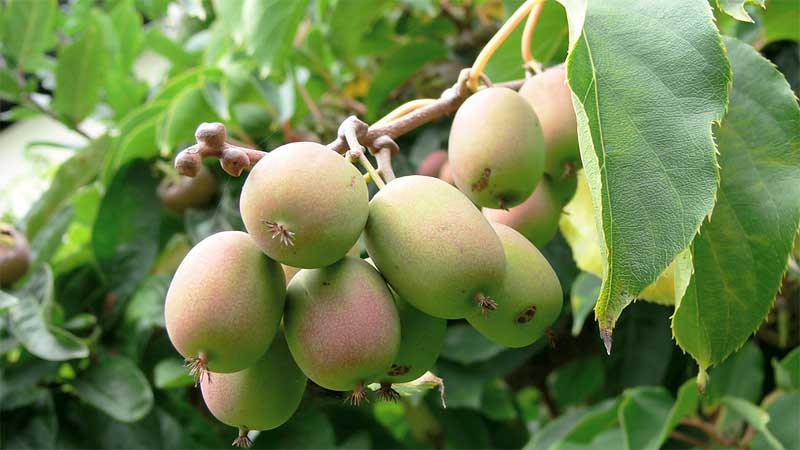
When and how to properly cover for the winter
You need to start covering actinidia only after how the vine will ripen, the foliage will turn yellow and fall and the most important thing - stable cool weather will be established, closer to 0 degrees (similar to grapes).
In general, you can remove actinidia from the trellis in advance and lay on the ground, and cover a little later (depending on the weather).
The best natural insulation is snow. Therefore, if you have the opportunity, you can yourself throw snow over the plant and do not cover with anything else, but this applies only to adult plants.
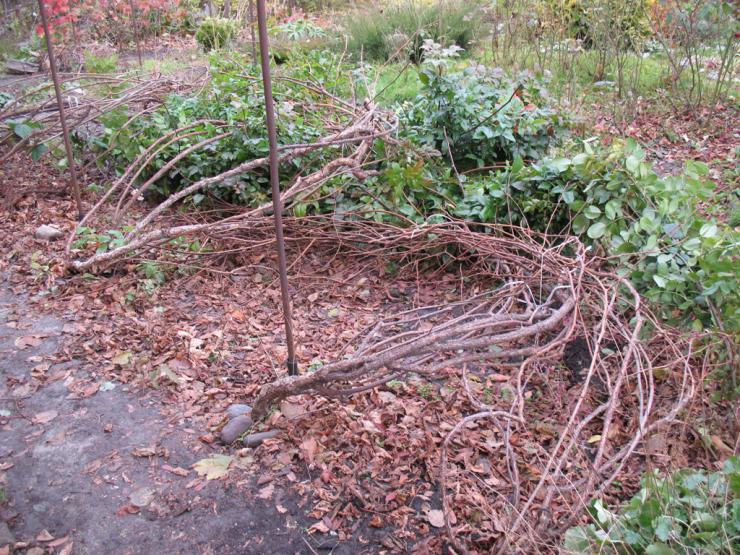
The trunk circle of an adult actinidia can be pre-mulched coniferous litter, rotted sawdust, peat, and then from above additionally put on bent and fixed shoots spruce branches (so that the snow lingers better).
In general, a similar shelter is suitable for young bushes, but only for regions with relatively mild winters and a lot of snow. In short, not for Siberia.
Video: preparing anemones for shelter - laying shoots, pinning them and protecting them from cats with a net
And now let's talk in more detail about the shelter of young actinidia bushes.
So you need remove the vines from the trellis, lay them on the ground and pin them (fasten with staples).
Next, you need to create air dry shelter. Namely, you need put the frame, which the fill inside with straw or spruce branches, a put on a polypropylene bag on top (out of sugar) or cover with spunbond, in short, use a breathable covering material (in no case a film, otherwise it will dry out).
In general, the shelter of a young actinidia is similar to how harbor roses for the winter or grapes.
Video: shelter of actinidia for the winter
Spring return frosts
In most cases, the winter shelter is removed already in April, but often the weather brings unpleasant surprises in the form of frosts in May, which can destroy awakened kidneys. In this case (with the threat of spring return frosts) actinidia (especially Arguta) should be covered with a covering material - agrotex (for example, spunbond or lutrasil).
Protection from animals (cats and cats)
It is fairly believed that actinidia is interesting to cats ... Unfortunately, their attention is attracted precisely by young shoots and leaves, which they like to gnaw (sometimes even at the root).
In this case, animals can break and then chew even mature shoots.
Accordingly, actinidia needs not only shelter, but also real protection. That is why some summer residents put it in a cage (close it with a net), namely, they surround the base of the bush with a metal mesh 1 m high and 50 cm wide so that pets cannot make their way to the main shoots.
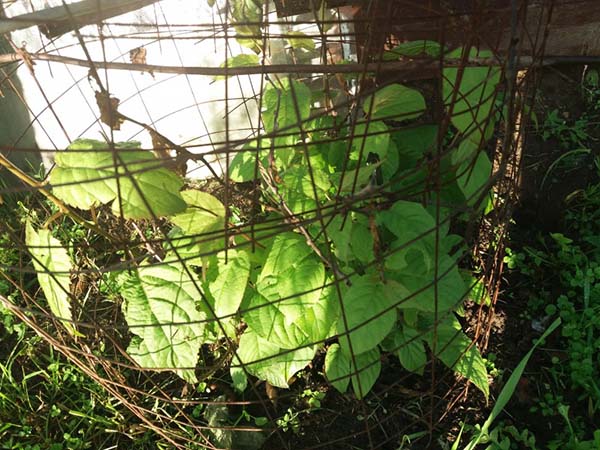
Why it happens?
Actinidia produces the same pheromones as valerian... Accordingly, if you shoot, lay on the ground, in short, stir up bushes, then the aroma exuded will certainly attract local cats.
The same applies to the spring period of sap flow, so in spring the plants must be covered with a net.
Video: cat and actinidia
Thus, now you know what to do with actinidia in the fall - how to properly cut and cover it for the winter so that it overwinters well and next year again delights you with abundant foliage, luxurious flowering and a harvest of delicious berries.
Video: actinidia arguta - reproduction, pruning and shelter for the winter and spring with return frosts


Thank you for your instructive article on caring for actinidia.